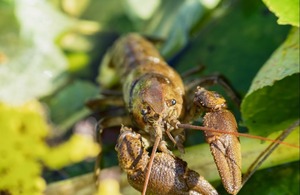Environment Agency delivers warning to anglers tempted to use illegal crayfish traps
The Environment Agency is reminding anglers that no crayfish trapping is authorised in Yorkshire

The white-clawed crayfish is already a threatened species with the illegal traps making it worse, the Environment Agency said
Fisheries Enforcement Officers are warning anglers who may be tempted to use crayfish traps, not to take the risk.
It is an offence to set these traps in Yorkshire, under the Salmon and Freshwater Fisheries Act (1975), and those who do, without explicit written permission, could face prosecution and a hefty fine.
Seven illegal traps were seized from Yorkshire waters in August and September last year, creating a threat to wildlife including the endangered, white-clawed crayfish and European eel.
Other species, including mammals, have also died because of them.
White-clawed crayfish are in decline in Yorkshire due to the invasive American signal crayfish, which is bigger and carries a disease deadly to the native population.
Trapping the signal crayfish can make the problem worse, as the crayfish plague is easily transferred from one watercourse to the next on other traps as well as on fishing equipment, clothing and footwear.
Robin Jennings, Fisheries Enforcement Officer for Yorkshire said:
“There are still populations of our indigenous white clawed crayfish in Yorkshire rivers, and this is a protected species which we work hard to safeguard.
“It’s a serious crime to set these hazardous traps and horrific to see evidence of mammals having drowned, as well as the other ecological impacts they can cause. Our officers regularly patrol watercourses throughout Yorkshire and people should be aware that anyone involved in such activity will face enforcement action.”
Members of the public who see any evidence of illegal traps are encouraged to report it to the Environment Agency’s 24 hour incident hotline on 0800 80 70 60.
Anyone who uses waterways for work, activities or sports is also asked to follow the Check Clean Dry guidance:
Check
Check your equipment and clothing for living organisms. Pay particular attention to areas that are damp or hard to inspect.
Clean
Clean and wash all equipment, footwear and clothes thoroughly. If you do come across any organisms, leave them at the water body where you found them.
Dry
Dry all equipment and clothing - some species can live for many days in moist conditions. Make sure you don’t transfer water elsewhere.